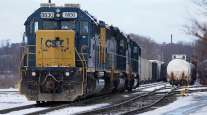CSX Caught Mid-Revolution by Death of Rail-Legend Harrison

With CEO Hunter Harrison’s death on Dec. 16, CSX Corp. lost the guiding hand of a railroading legend who added almost $17 billion in value in less than a year.
Now, acting CEO Jim Foote will have to prove to investors that Harrison’s rapid transformation of CSX was deep enough to deliver lasting efficiency and profit. Adding to the challenge: Foote, 63, arrived at the company less than two months ago, one of several new faces Harrison brought aboard after purging longtime executives.
RELATED: Hunter Harrison, CEO at CSX, dies at 73
“You brought in the post-revolutionaries before the revolution was done,’’ said Tony Hatch, founder of ABH Consulting, which specializes in railroads. That could slow down some of the changes still needed, such as an overhaul of how container freight is hauled, he said.
Harrison became CEO in March and promptly rammed through the most disruptive part of his strategy — shutting down switching yards, cutting jobs, parking locomotives and scheduling freight pickups more evenly throughout the week. The changes irritated shippers and hurt service, just as they did during Harrison’s earlier stints running Canadian National Railway Co. and Canadian Pacific Railway Ltd. Smoothing those bumps is where Foote’s own railroad background — in investor relations and marketing — may come into play.
“The hard part is already done — it’s really about fine-tuning and execution going forward,’’ said John Larkin, an analyst with Stifel Nicolaus & Co. “Jim Foote knows what he’s doing. He’s experienced and familiar with precision railroading.’’
Even with Foote’s experience, analysts at Cowen & Co. and Morningstar said CSX ultimately may find better alternatives for the permanent position.
Harrison’s Death
Harrison, 73, died Dec. 16, less than two days after the Jacksonville, Florida-based railroad said he was taking medical leave. While CSX said only that he died from complications from a recent illness, Harrison had a history of health problems that included heart bypass surgery in 1998 and pneumonia in 2015.
CSX shares gained 60% this year through Dec. 14, reaching a market value of $51.2 billion, mostly after Harrison said in January that he would leave Canadian Pacific and seek the top job at CSX with the backing of an activist shareholder. The stock dropped 2.2% to $51.75 at 8:57 a.m. in premarket trading Dec. 18 in New York, following a 7.6% decline Dec. 15 after the medical leave was announced.
Investors had taken a chance on Harrison’s health hoping to duplicate his successes at Canadian National and Canadian Pacific, where it took him less than a year to dramatically increase earnings. Shareholders voted to pay Harrison $84 million that he relinquished upon leaving Canadian Pacific early, even though they knew he required supplemental oxygen to treat shortness of breath and turned down CSX’s request to review his medical records.
Harrison had come out of retirement to join the Canadian carrier at the urging of activist investor Bill Ackman, who engineered a boardroom coup to install the railroader. Then North America’s least efficient railroad, Canadian Pacific now is hailed for a smooth-running operation that helped triple net income during Harrison’s tenure.
He teamed up with another activist investor, former Ackman partner Paul Hilal, for his move to CSX. Harrison’s focus on so-called Precision Scheduled Railroading forced shippers to comply with CSX’s new timetables, rankling customers including Chemours Co. and Charles Ingram Lumber Co. The U.S. Surface Transportation Board held a hearing in October after receiving complaints about “widespread degradation” of service. Hunter argued that the efficiencies CSX was putting in place would benefit shippers in the end.
Foote and CSX are now forced into the relationship-repairing phase earlier than the two Canadian railways experienced under Harrison, consultant Hatch said. “They’ll get to a marketing, customer friendly, outwardly kinder and gentler carrier quicker because they’ve entered that phase sooner than they would have if Hunter were CEO, but they might not finish the revolution,” he said.
This is Foote’s first test as CEO of a major corporation. Before joining the company in late October, he was the boss at Bright Rail Energy, a startup that offers natural-gas electricity generation to assist in powering locomotives. Prior to 2009 he had been head of investor relations and later chief marketing officer at Canadian National.
Foote will have to keep the transformation moving with a relatively new team. Harrison had pushed out CSX’s operating and sales chiefs, leaving few senior executives with long tenures, and weeded out other employees who didn’t embrace fully his techniques.
‘Rock Stars’
In October, Harrison discussed identifying some “rock stars’’ within the CSX ranks that would help fill senior positions. He also immersed about 150 employees in the precision-railroad theory in so-called Hunter camps. Shortly before his death, Harrison had brought in about two dozen managers from other railroads experienced in his techniques.
“CSX’s senior management team and board need to address several questions to give investors a better sense that CSX will be another success story, even without Harrison at the helm,” wrote Lee Klaskow, an analyst at Bloomberg Intelligence. Shareholders will have to wait until the railroad’s investor day in March, when management likely will lay out goals and introduce the managers who will execute Harrison’s vision, Klaskow wrote.
Like Harrison, Foote is an old-school railroader who began his career at 18 working out of the tool shed in the mechanical department of the Soo Line Railroad in Superior, Wisconsin. Foote said he’s gained broad experience from digging ditches and fixing locomotives to working himself up the management ranks to run the marketing department and operate the intermodal business at Canadian National.
The March investor meeting would also be a test for Foote; analysts say that while he’s capable, there’s disagreement about whether he’s ready for the job on a permanent basis.
“We do not view this as a long-term solution for the company and expect the Board to start looking inside and outside the organization for a long term successor to Harrison,’’ said Jason Seidl, an analyst with Cowen & Co., in a Dec. 15 note following the announcement of Harrison’s medical leave.
At Morningstar Inc., Keith Schoonmaker on Sunday suggested that Canadian Pacific CEO Keith Creel, a longtime Harrison understudy, “would have the greatest probability of maintaining Harrison’s pace” if he were interested and not locked into place.
Consultant Hatch said investors will find Foote up to the task: “Those who know Jim have great confidence in him, and the rest of them will gain it.”
With assistance by Frederic Tomesco




